Helpful Summary
- Overview: We introduce the concept of sprint velocity in Agile software development and explain how to do planning and forecasting to optimize for this metric.
- Why Trust Us: We’re a leading tool for async daily standups, backlog refinement, and retrospectives trusted by companies like T-Mobile, Angi, and Hello Fresh.
- Why It Matters: Optimizing sprint velocity allows teams to deliver more value to customers and stay on track with project timelines.
- Action Points: We suggest prioritizing the backlog, breaking down user stories into manageable tasks, making accurate story point estimations, planning based on team capacity, engaging in regular retrospectives for continuous improvement, and fostering adaptability and effective communication.
- Further Research: Check out the Teaminal blog for more guidance on doing async Agile effectively.
Wondering How to Optimize for Sprint Velocity?
Agile methodologies have become the cornerstone for software development teams aiming to deliver high-quality products efficiently. And one important metric that measures the effectiveness of Agile processes.
However, optimizing Agile planning for sprint velocity can be a challenge for many teams.
At Teaminal, we understand that optimizing sprint velocity is essential for accurate planning and forecasting. And in this article, we will share some tips and strategies to help you achieve this goal.
But first…
Why Listen to Us?
At Teaminal, we’ve helped high-performing teams at major companies like Medium, Hello Fresh, Angi, and T-Mobile implement more effective Agile ceremonies. Our expertise lies in optimizing processes so that distributed teams can work seamlessly together and deliver top-notch products in record time.

The bottom line? We know Agile planning inside and out, and we’re here to help you do it right.
What Is Sprint Velocity?
Sprint velocity refers to the amount of work a team can complete in a single sprint. This measurement is usually represented in story points, hours, or any other unit of estimation that the team uses to gauge the size or complexity of tasks in their backlog.
In a traditional Agile setting, teams work in synchronous cycles, with daily stand-ups and regular sprint planning, review, and retrospective meetings. Sprint velocity is calculated by summing up the points (or any other units of measure) for all the tasks that were fully completed during the sprint.
How Do You Calculate Sprint Velocity?
Sprint velocity is pretty easy to calculate—it’s the total units of work (e.g., story points) completed by the team during a single sprint (or day if you want to compare sprints of varying lengths).
For example, if your team completes 20 story points in a 10-day sprint, your sprint velocity is either:
- 20 points per sprint
- 2 points per day
Sprint Velocity in Async Agile
Async Agile adapts Agile methodologies to environments where team members may not work at the same time due to time zone differences, flexible schedules, or remote work policies. In async Agile, communication does not happen in real time. Instead, updates, decisions, and feedback are shared through tools like Teaminal that allow team members to access the information when they’re working.
In this context, calculating sprint velocity is still equally important, but might require adjustments in communication and tracking methods. Teams might rely more heavily on digital tools for updating task statuses, estimating work, and sharing progress to make sure that everyone has access to the latest information—regardless of when they work.
Why Is Optimizing for Sprint Velocity Important?
Optimizing your Agile process around sprint velocity is important for several reasons:
- Facilitates Effective Sprint Planning: Knowing the team’s average sprint velocity simplifies sprint planning, allowing for realistic story selection without overloading the development team.
- Manages Stakeholder Expectations: Sprint velocity gives stakeholders a clear understanding of what to expect from the team, which leads to better communication and collaboration.
- Signals Potential Issues: A sudden dip in velocity may indicate roadblocks that require attention, ensuring smooth progression to subsequent sprints.
- Promotes Continuous Improvement: By tracking performance over multiple sprints, teams can identify patterns, address bottlenecks, and enhance productivity.
- Ensures Transparency and Accountability: It offers visibility into progress against targets and individual contributions towards collective goals.
Challenges in Measuring and Improving Sprint Velocity
- Variability: Velocity can vary from sprint to sprint due to human factors, technical difficulties, and other external dependencies.
- Misinterpretation: Sprint velocity shouldn’t be considered an absolute measure of productivity but rather as a tool for planning and improvement.
- Overemphasis on Velocity: Focusing too much on increasing velocity can be counterproductive, leading to stress and decreased productivity.
How to Optimize Your Agile Process for Sprint Velocity
1. Consider Async Agile Meetings
If your team is distributed, one of the most impactful ways to optimize your Agile process for sprint velocity is to hold asynchronous meetings.
Synchronous meetings are irreplaceable in certain situations—but they’re overused. The average US worker spends more than half (21.5 hours) of their 40-hour workweek in meetings, and only 30% are considered “productive”. Async Agile meetings solve this problem by allowing team members to participate on their own time.
How do async Agile meetings work? That depends on the tool you use.
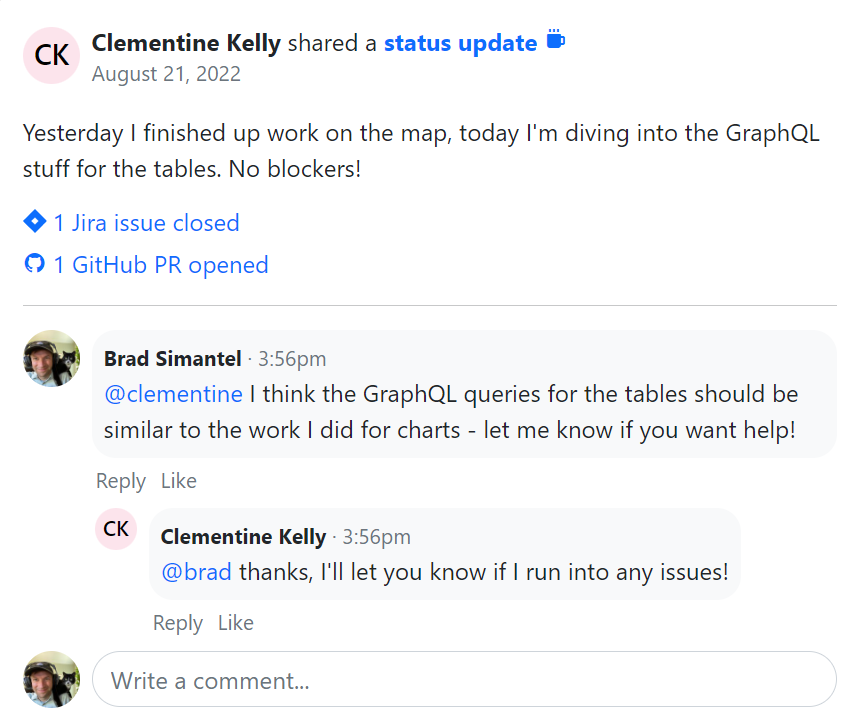
Teaminal integrates with Slack and lets you conduct async standups, backlog grooming, planning poker, and retros without leaving your chat app. Managers initiate different Agile meetings, team members get Slack notifications to contribute, and everyone gets updates in real-time.
We’ll talk more about the specifics later.
2. Make Sure Your Backlog Is Refined
Poor backlog refinement is often a major source of inefficiency in Agile teams. Without proper prioritization, team members end up working on tasks that are not the most important or valuable to the project.
So, how do you do backlog prioritization well?
For starters, find a tool that helps you keep your backlog refined. Teaminal does this by automatically pulling in old backlog items for you to review. If they’re outdated or irrelevant, they can easily be removed from the backlog.
Next, focus on organizing your backlog by value. In this content, “value” is defined as the impact a task or feature will have on the end product. This can include factors like customer satisfaction, revenue potential, or competitive advantage.
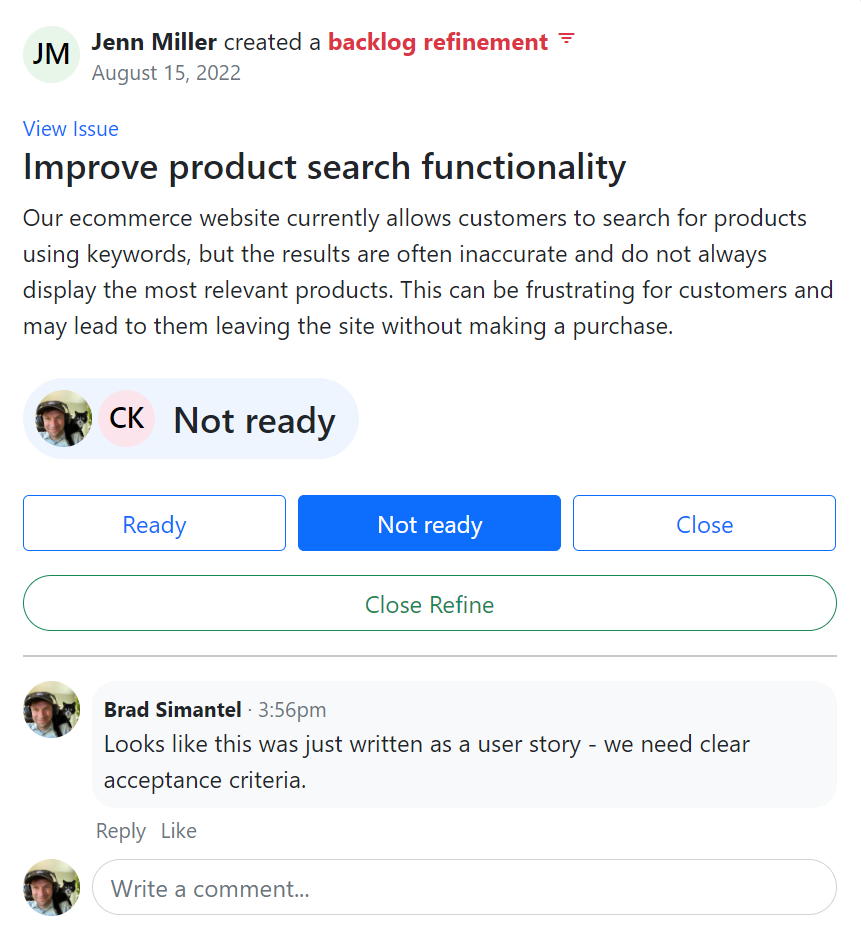
Finally, make sure your whole team is involved in the prioritization process. With Teaminal, this is as easy as starting a backlog refinement session where everyone can discuss acceptance criteria and priority, and vote on whether a task is ready to be scheduled.
3. Break Down User Stories
Large and complex user stories can be a roadblock to efficient development.
Breaking down user stories into smaller, manageable tasks makes it easier to estimate and complete them within a single sprint. This approach also provides more visibility into progress and allows for better tracking of individual tasks.
Teaminal’s async planning poker feature lets teams estimate tasks using a point-based system without leaving Slack. If a certain item has too many points, it can be further broken down into smaller tasks until it’s at a manageable level.
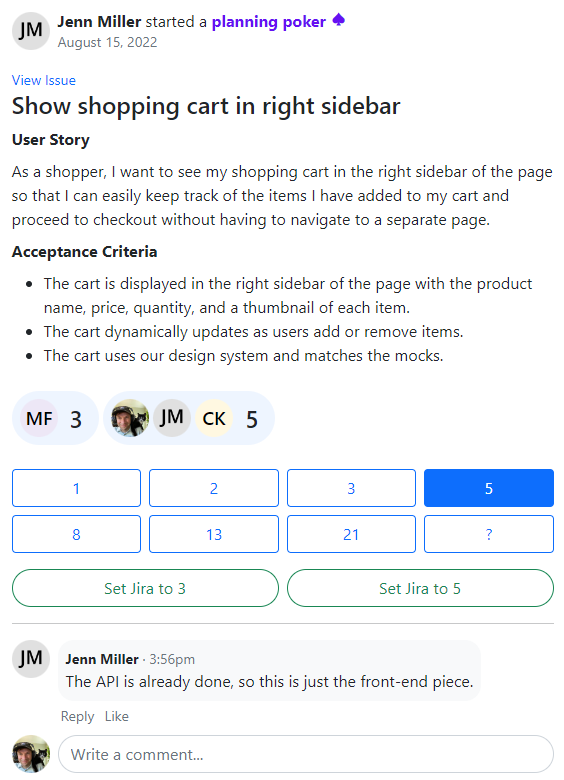
One velocity-boosting idea is to create a tiered structure for user stories.
For example, in Basecamp’s Shape Up methodology, they have two units—big and small. Big projects will take a team the entire cycle to complete, while small ones can be finished in 1–2 weeks. Each unit is defined by a story point threshold, so it’s easy to tell during planning whether a project is big or small.
How does this help with sprint velocity? It makes planning much more efficient. Instead of trying to fit a bunch of irregularly sized user stories into a regularly sized sprint, you’re working with units of work that are designed to fit nicely together.
4. Work on Accurate Story Point Estimations
And that brings us to a related point—accurate story point estimations.
Your sprint velocity depends on how well you can estimate the size and complexity of your user stories. If you consistently underestimate or overestimate, it will throw off your sprint velocity and make planning more difficult.
Story points are a relative measurement of complexity and effort required to complete a user story. They’re usually represented using the Fibonacci sequence (1, 2, 3, 5, 8, etc.) to reflect the uncertainty and unpredictability of software development. These are usually voted on in a planning poker session during backlog refinement (or sprint planning, if necessary).
To get better at story point estimation, you need to compare estimates to reality.
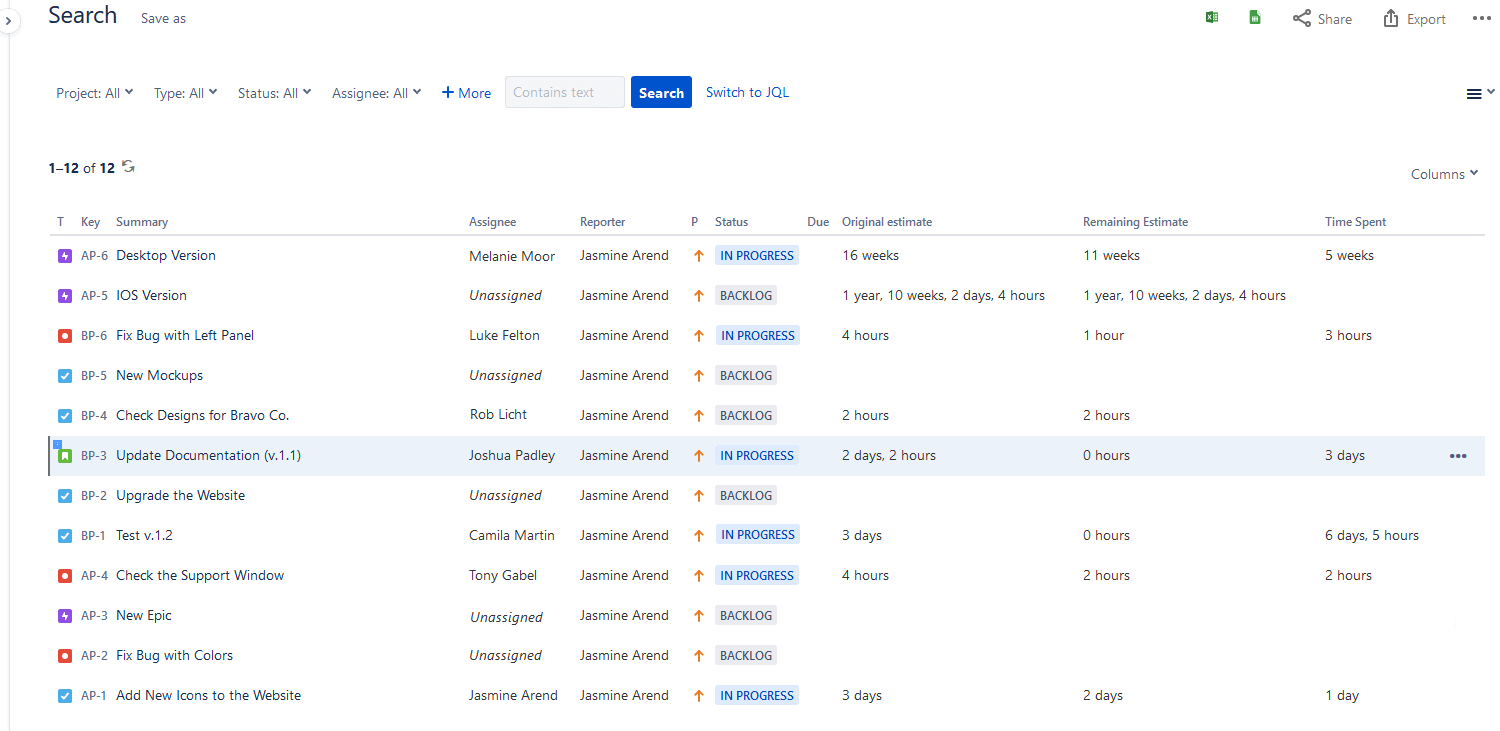
Think of this as a calibration exercise. Each team member approaches problems with a bias (which we can generalize as either optimism or pessimism). Both can lead to skewed estimates, so the goal is to help your team get better at recognizing and self-correcting these biases.
In practice, this just means asking your team to compare their estimates to the actual effort it took to complete the user story. This can be done through retrospectives or by tracking actual time spent on each task.
5. Get Better at Capacity Planning
Understanding the team’s capacity is important for realistic planning and delivery. Capacity planning involves estimating the amount of work that can be completed in a given period and making sure it aligns with the team’s goals and priorities.
Capacity planning deserves a post of its own, but here’s the gist of how it works:
- Ask each team member to write down how many hours they could ideally spend on each of their tasks in a given week.
- Add up the capacities of all team members in identical roles to get the total team capacity for the week.
- Compare this total capacity to the amount of work that needs to be completed in a given week.
- If there is more work than capacity, prioritize tasks and consider adjusting deadlines or delegating tasks to other team members.
There’s a bit more to it, but this basic framework can help ensure that the team is not overwhelmed with work and that tasks are completed in a timely manner. It also allows for flexibility in case of unexpected events or changes in priorities.
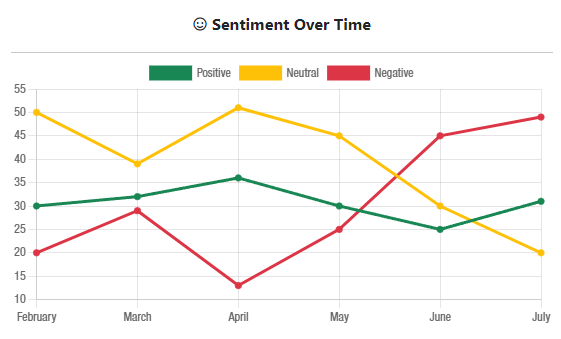
You can use Teaminal’s team sentiment report to validate team capacity and workload distribution based on how your team is feeling. If sentiment suddenly drops, it may be a sign that the workload is becoming too much for the team to handle.
6. Hold Regular Retrospectives
Continuous improvement is a fundamental principle in Agile methodologies.
Regular retrospectives provide teams with an opportunity to reflect on their processes and identify areas for improvement. By addressing challenges and optimizing workflows, teams can enhance their efficiency over time, ultimately leading to an increase in sprint velocity.

Teaminal includes features specifically designed for facilitating async retrospectives that offer valuable insights without eating up hours of development time each month.
Here’s an overview of how they work:
- To facilitate recalling the sprint’s activities, your progress updates are displayed in a sidebar, while the closed Jira issues/GitHub PRs (or similar data from other integrations) worked on by the entire team are listed.
- You have the option to customize the discussion prompts, but the default ones are “What went well?”, “What didn’t go well?”, and “Kudos.” Valuable discussions and improvements often stem from the “What didn’t go well?” section.
- In situations where trust within the team is still developing, or when there are sensitive topics to address, retrospectives can be conducted anonymously. Any action items identified during the retrospective can be documented and later tracked on a dedicated page for ongoing follow-up.
By tracking the action items that come out of retrospectives, Teaminal ensures that continuous improvement measures are implemented and followed up on.
6. Prioritize Adaptability and Flexibility
Agile is all about adaptability.
Teams should be flexible in adjusting their plans based on feedback, changing priorities, or unexpected challenges. Embracing change and adjusting sprint goals as needed allows teams to maintain momentum and deliver value even in dynamic environments.
Agile boards in Teaminal enable teams to quickly adapt their plans based on new information, feedback, or changes in priorities. These boards facilitate flexible sprint planning and real-time adjustments.
7. Invest in Team Collaboration and Communication
Effective communication and collaboration form the foundation of successful Agile teams. Open channels among team members promote shared goals, understanding, and quick decision-making.
Teaminal provides a comprehensive solution for enhanced team communication and collaboration, significantly boosting efficiency and productivity. By offering a central platform for communication and collaboration, Teaminal streamlines processes, cutting costs for businesses.
Everything you do in Teaminal can be done through Slack (or Teaminal’s web app) to make communication as seamless as possible. Our platform also has deep integrations with tools like Jira, Asana, GitHub, and GitLab, so your data is always up-to-date and easily accessible.
Best Practices for Optimizing Sprint Velocity
Consistent Team Composition
Consistent team composition is a big factor in achieving a high sprint velocity.
Even if everyone you work with is equally talented, moving team members around frequently can disrupt the flow of work and cause delays. It takes time to get up to speed on a project or task, and every unit will have a slightly different dynamic that needs time to solidify.
Calculate a Running Average Sprint Velocity
Sprint velocities naturally fluctuate due to variations in behavior, team composition, time of year, etc.
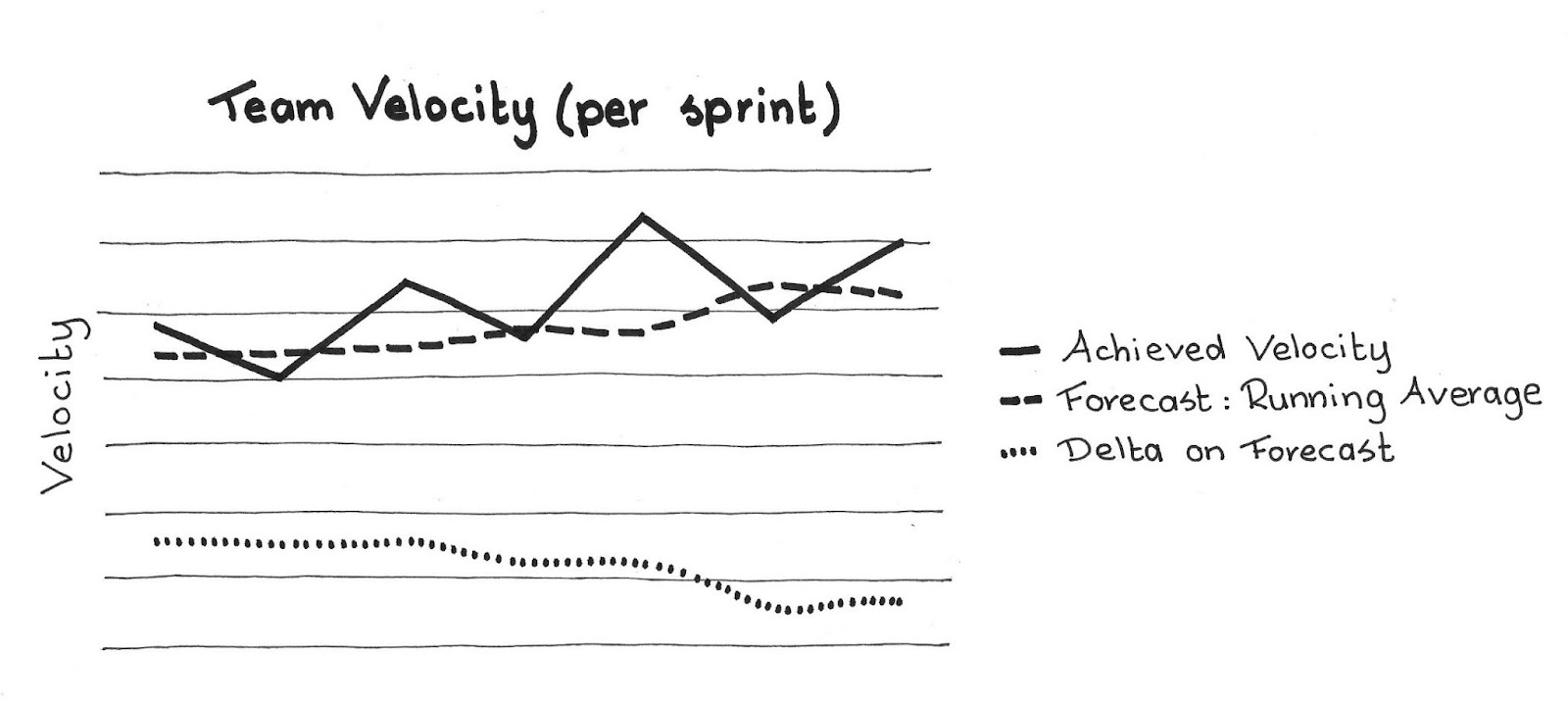
To get a more accurate idea of your team’s velocity, it’s best to calculate a running average. This means taking the velocities of your past 3–4 sprints and avenging them to forecast for the upcoming sprints on a running basis.
This makes it much easier to spot trends and adjust your team’s workload accordingly. For example, if you notice a consistent decrease in velocity over the past few sprints, it may be time to reassess priorities or address any issues within the team.
Clear Definition of Done (DoD)
DoD is an important concept in Agile project management.
It serves as a set of criteria that need to be fulfilled for a task or user story to be considered complete. By having a well-understood and consistently applied DoD, teams can establish clear expectations and standards for work completion. This helps in minimizing rework and ensures that deliverables are genuinely finished by the end of a sprint.
A typical DoD encompasses various elements, including:
- Meeting Acceptance Criteria: All conditions or acceptance criteria outlined for a task or user story are met.
- Quality Assurance: The work meets established quality expectations, ensuring a high standard of output.
- Value Delivery: The work adds value to the end-user or customer, aligning with the project’s goals.
- Consistency: The work is consistent with the team’s standards and expectations, fostering uniformity in the delivered output.
Limit Work in Progress (WIP)
Work in Progress (WIP) refers to the number of tasks or projects that a team or an individual is currently working on but has not yet completed. Setting WIP limits involves putting a cap on the maximum number of tasks that can be in progress at any given time.
Why Set WIP Limits:
- Improve Focus: By restricting the number of ongoing tasks, individuals or teams can concentrate better on completing existing work without getting overwhelmed.
- Reduce Context Switching: Context switching, or moving between different tasks, can be time-consuming and mentally taxing. WIP limits help minimize this by emphasizing task completion before taking on new ones.
- Enhance Productivity: With fewer tasks in progress, teams can streamline their workflow, reduce handoff delays, and boost overall efficiency.
Conclusion
Optimizing sprint velocity in Agile is an ongoing journey that requires dedication, collaboration, and a commitment to continuous improvement.
By prioritizing the backlog, breaking down user stories, refining estimation techniques, and fostering a culture of adaptability and collaboration, Agile teams can unlock higher levels of efficiency and consistently deliver value to stakeholders. Through these strategies, organizations can navigate the complexities of modern software development with confidence and agility.
By leveraging Teaminal throughout your process, you can significantly enhance sprint velocity, delivery quality, and team productivity. With real-time collaboration tools, a deep Slack integration, and a range of supported meetings, Teaminal empowers Agile teams to eliminate common roadblocks and focus on delivering results.
Get started for free.




